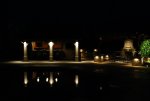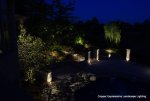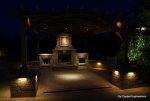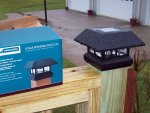Backyard lighting
- Thread starter lights4U
- Start date
You are using an out of date browser. It may not display this or other websites correctly.
You should upgrade or use an alternative browser.
You should upgrade or use an alternative browser.
I always love uplighting on trees/landscape. Something I want to add after our pool is in, in fact, I think I'm going to highjack some of the trenches that have to be dug for the pool and put in some conduit for future lighting. I'd like to do it all at the time of the pool, but we don't have all our landscaping in and I'm maxing out my budget for pool stuff.
Is that all direct wiring or low voltage? LED or traditional?
Kelly
Is that all direct wiring or low voltage? LED or traditional?
Kelly
- Nov 5, 2008
- 2,598
Wow, that is a lovely light system. Looks like a $15+K job, I'll guess, and really well suited to the top notch pool area.
We added low voltage lighting ourselves at the prior house and it really is not hard. You need to do a lot of planning and some calculating for voltage drops with long lines but it is pretty easy. There are lots of sources for metal light fixtures and bulbs. The direct bury line can be found in 100' reels in larger cities, pretty expensive to mail, maybe available at Home Depot as well. We used 20 watt halogens at the old house, this house has a professionally designed system using 35 watt PAR bulbs (like car headlights), much more expensive per bulb and bigger fixtures too. More expensive bulbs claim longer run times and when bulbs start burning out you will be buying bulbs by the case.
The biggest difference I see in my design and the professional one is that they used very pretty SS housing to cover ordinary timers and they used a hub and spoke system to minimize line voltage drop. A main line was run out to the yard then 5 lines for individual lights were attached inside a box similar to irrigation valve covers. There were maybe 5 or 6 main lines off each transformer, 3 transformers total. Yeah, with those bulbs it kinds looks like Disneyland here at night but they highlighted the landscaping very well and it does look nice. I think the longer distances do warrant the higher wattages compared to the old house. Took awhile to get used to it though and I have to wonder just how much of the electric bill is due to those 30 (or 40) 35 watt bulbs.
As you consider design, do remember how often you will be replacing bulbs and be wary of those up in trees for squirrels will chew on lines and the tree will grow over the line and break it, you need to allow a lot of slack for growth and reposition lines every few years before it is grown over totally.
And one more thing, just a pet peeve of mine; when lighting the front yard, do not use the path markers for outlining the flower beds. That is just wrong. Those pagoda style lights just don't work in the typical small front yard where they are at eye level to people driving by. There are so many specific styles of fixtures, for every special use, that one ought to be able to light driveways and highlight the house or plants with strategic floodlights without having lights that shine toward drivers.
We added low voltage lighting ourselves at the prior house and it really is not hard. You need to do a lot of planning and some calculating for voltage drops with long lines but it is pretty easy. There are lots of sources for metal light fixtures and bulbs. The direct bury line can be found in 100' reels in larger cities, pretty expensive to mail, maybe available at Home Depot as well. We used 20 watt halogens at the old house, this house has a professionally designed system using 35 watt PAR bulbs (like car headlights), much more expensive per bulb and bigger fixtures too. More expensive bulbs claim longer run times and when bulbs start burning out you will be buying bulbs by the case.
The biggest difference I see in my design and the professional one is that they used very pretty SS housing to cover ordinary timers and they used a hub and spoke system to minimize line voltage drop. A main line was run out to the yard then 5 lines for individual lights were attached inside a box similar to irrigation valve covers. There were maybe 5 or 6 main lines off each transformer, 3 transformers total. Yeah, with those bulbs it kinds looks like Disneyland here at night but they highlighted the landscaping very well and it does look nice. I think the longer distances do warrant the higher wattages compared to the old house. Took awhile to get used to it though and I have to wonder just how much of the electric bill is due to those 30 (or 40) 35 watt bulbs.
As you consider design, do remember how often you will be replacing bulbs and be wary of those up in trees for squirrels will chew on lines and the tree will grow over the line and break it, you need to allow a lot of slack for growth and reposition lines every few years before it is grown over totally.
And one more thing, just a pet peeve of mine; when lighting the front yard, do not use the path markers for outlining the flower beds. That is just wrong. Those pagoda style lights just don't work in the typical small front yard where they are at eye level to people driving by. There are so many specific styles of fixtures, for every special use, that one ought to be able to light driveways and highlight the house or plants with strategic floodlights without having lights that shine toward drivers.
bk406
0
Thats a nice system. Mine is a hub and spoke system. Main lines run from the transformers out to spder junction boxes in the ground. I have several in trees, planting beds, up lights on the house and shadowing effect lights as well. All total 62 lights with the most being 50 watts, some 20, and the majority 35. It adds around 30-40 a month to the electric bill. Compared to the christmas lights which add almost $100 during december.
Thank you for the nice complements everybody.
It sounds as though some of you have some pretty nice low voltage landscape lighting systems installed. One thing I would recomend to all is that you perform maintenance on your systems once or twice annually. Most of you might already have a company doing this for you. The average life span of a MR 16 bulb is 4000hrs and a PAR 36 is usually 2000hrs. After those hours have expired the bulbs might still work but the amount of light output is drastically reduced which hampers the orginal lighting design.
The other important part is when you are changing out the light bulbs ensure that you are replacing them with the same wattage as the original bulb. (this is very important as it can severly change the ampacity and voltage of your system.)
Ken
It sounds as though some of you have some pretty nice low voltage landscape lighting systems installed. One thing I would recomend to all is that you perform maintenance on your systems once or twice annually. Most of you might already have a company doing this for you. The average life span of a MR 16 bulb is 4000hrs and a PAR 36 is usually 2000hrs. After those hours have expired the bulbs might still work but the amount of light output is drastically reduced which hampers the orginal lighting design.
The other important part is when you are changing out the light bulbs ensure that you are replacing them with the same wattage as the original bulb. (this is very important as it can severly change the ampacity and voltage of your system.)
Ken
bk406
0
lights4U said:ensure that you are replacing them with the same wattage as the original bulb. (this is very important as it can severly change the ampacity and voltage of your system.)
Ken
Yes, good to point out. With a multitap transformer, voltages are balanced for each spider junction to around 12 volts by hooking the spider up to different voltage outputs on the transformer to balance everything for the wattage on the spider as well as the distance. A change in wattage on one bulb can change the current draw. These systems are designed to draw around 25 amps, total.
- Mar 14, 2011
- 151
Our local GA Home Depots are selling these solar deck post cap lights for $3.88. (about 1/4 price of what I had previously seen)
Bought 20, so far they look and work great. Not enough light for real path lighting, (more like moon glow) but cool looking.
Bought 20, so far they look and work great. Not enough light for real path lighting, (more like moon glow) but cool looking.
Attachments
- Mar 23, 2010
- 252
I had considered getting post cap lights for my vinyl fence like that. I love the idea of solar but I really need more light than the dim 2 LED models I've seen.
Does anyone have any suggestions for sources to purchase low voltage lights and trasformers? I tend to purchase everything I can online, but also have access to Home Depot, Lowes, etc. My landscaper is offering to install and has said that he can put in a nice system for "about $1000". In my experience, that means that the parts for what he's planning on installing is about $500-600, which I might be able to decrease with purchasing direct.
Check Ewing (see if they have an office near you), most of the stuff they sell is direct to landscapers. I picked up my sprinkler control for about 40% off retail.
http://www.ewing1.com/
http://www.ewing1.com/
rv4hess said:Our local GA Home Depots are selling these solar deck post cap lights for $3.88. (about 1/4 price of what I had previously seen)
Bought 20, so far they look and work great. Not enough light for real path lighting, (more like moon glow) but cool looking.
Hi, I'm new to the boards. just looking for Deck/AGP idea.
Just ordered 9 they were 4.88 at the Erie, Pa HD
Thread Status
Hello , This thread has been inactive for over 60 days. New postings here are unlikely to be seen or responded to by other members. For better visibility, consider Starting A New Thread.
Similar threads
- Replies
- 50
- Views
- 501
- Replies
- 5
- Views
- 327
- Replies
- 45
- Views
- 811





